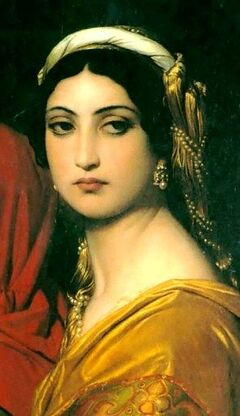Difference between revisions of "Amelia Paulina, Baroness of Virdain"
m |
|||
| Line 11: | Line 11: | ||
|-class="wikitable" style="background:#e4dcf6; text-align:center; margin-left: 10px;" | |-class="wikitable" style="background:#e4dcf6; text-align:center; margin-left: 10px;" | ||
|- | |- | ||
| − | | <span style="font-size:small;">'''Born''': ||<span style="font-size:small;"> 19th of Godfrey's Triumph <br> [[Karosgrad]], [[Kingdom of Hanseti-Ruska|Haense]] | + | | <span style="font-size:small;">'''Born''': ||<span style="font-size:small;"> 19th of Godfrey's Triumph, 1892 <br> [[Karosgrad]], [[Kingdom of Hanseti-Ruska|Haense]] |
|- | |- | ||
| <span style="font-size:small;">'''Born''': ||<span style="font-size:small;"> Alive | | <span style="font-size:small;">'''Born''': ||<span style="font-size:small;"> Alive | ||
Revision as of 15:46, 2 April 2023
|
| ||||||||||||||||
Amelia Paulina Varoche (19 Godfrey’s Triumph, 1892) was a twentieth century Adrian poet.
Born in Karosgrad, Amelia and her family immigrated to Adria around her tenth birthday. Amelia received a somewhat liberal education from her father - but nothing that deviated too much from the standards of women’s education at the time. Upon her mother’s death in 1901, Amelia inherited her poetry collection, which contained the works of Haeseni Poets. Feodor May’s poetry in particular had greatly inspired Amelia to write her own.
Contents
Early life and Adolescence
Amelia Paulina Varoche was born on the 19th of Godfrey’s Triumph, 1892, within the city of Karosgrad to Sigismond Varoche and his first wife, Ipera Antoinette. Amelia spent most of her early childhood in the capital of Haense, relocating to the Adrian Camp around her tenth nameday. Moving to Adria had caused dramatic changes in Amelia’s lifestyle, as she increasingly acquired an Adrian accent and a harsher personality, undoing the demure and quiet girl in Haense. In 1910, Sigismond remarried to Anna of Alstion. The two had a cordial relationship, and Amelia enjoyed talking to Anna – and in later years, Amelia wrote various poems about Anna, her first being Epitaph. Amelia, now twenty, had seeked out Anna for help in securing a marriage – to which Anna suggested Otto Carolus von Bardenwig. Upon meeting the Baron, Amelia deemed him boring and uninteresting — thus, she turned to her father for help.
Sigismond suggested one of Heinrik’s brothers. Delighted by the idea that her own children could potentially be the Duke of Adria one day, she agreed. In the meantime, Amelia attended the Herbertine University — a prestigious arts university. Amelia studied poetry, philosophy, and literature there, where she planed to complete a four year program there, however she had to drop out shortly after the Adrian Rebellion began. To attend the school, Amelia submitted a play she had written titled Il Complotto Della Moglie. Unfortunately for Amelia, the plot to marry the brother of the Duke fell through, as Amelia contracted influenza and was bedridden for two weeks. Once she recovered, the newly appointed Baron of Virdain proposed to her at a ball hosted at the Château de Lucienne. Amelia, who already deeply admired the Baron, accepted on the condition he gain approval from her father. It was reported by attendees of the ball that the two shared a 'most intimate dance'.
Adrian Rebellion
The War:Adrian Rebellion broke out shortly after Fernand’s proposal, however. With the Varoche family at the forefront of Adrian politics and high society, many had expected Sigismond to be the next Duke of Adria – which very well could’ve been the case. However, in 1916, Sigismond, Charles, King of Aaun, and a number of Adrian vassals published Heinrik’s Folly. Anna, Sigismond’s new wife, had garnered public support for the cause and Amelia, fearing a rebellion from the Adrians and the Neo-Renatians (who were named in the document for burning down the Golden City of Ves centuries prior), retreated to the newly constructed Varoche Manor in the countryside. The Duke quickly published a missive demanding for Adrian Independence, sparking the rebellion.
Amelia fled from the Varoche manor under the guise of the night, arriving at Fernand’s barony where she sought refuge. She retreated from the public eye for the first two years of the war, instead remaining inside the Château de Lucienne. Her father and brother, Sigismond and Charles, were captured the following year within the Commonwealth of the Petra, and the two were executed in the square of Velec. Amelia, deeply depressed now, became a recluse - only venturing outside Fernand’s barony to harvest grapes and collect berries. After a run-in with an Adrian nationalist, which almost resulted in her life, Amelia sought refuge in Minitz with her friend Henriette de Lewes. She stayed there for about two months, until she received a letter from her youngest sister, Lorina. Amelia thus fled to the Barrowlands to live with her favorite sister.
It was never recorded if Amelia had entered an official state of mourning. Her poem, Epitaph, has been argued by scholars to be a sort of mourning poem - yet it is unclear if it truly is. What is known however, is that Amelia became a shell of her former self, once catty and sarcastic, she was now well-tempered and quiet.
Literary works
Style and themes of works
In 1912, Amelia published her first play – titled Il Complotto Della Moglie, which she had submitted to attend the Herbertine School. The play was a mild success, following the story of Salvatore, his wife driven to madness, Anna, and his mistress, Paloma. Anna murders Salvatore, then committing suicide. In the original staging, which was planned to tour around the Canonist realms, Austina of Aldersberg was rumored to play Anna, and Amelia portraying Paloma. However, no one was found to portray Salvatore and alongside Austina’s death, the show was never staged. Amelia often explored nature in her poems, often beginning them with a scene she lived close to. As for her style, scholars and academics agree that she was inspired heavily by Haeseni Poets such as Borris Iver Kortrevich, Feodor May, and her own mother, Ipera Antoinette.
Bibliography
Il Complotto Della Moglie – 1912
CHAPBOOK: Five Poems – 1918

